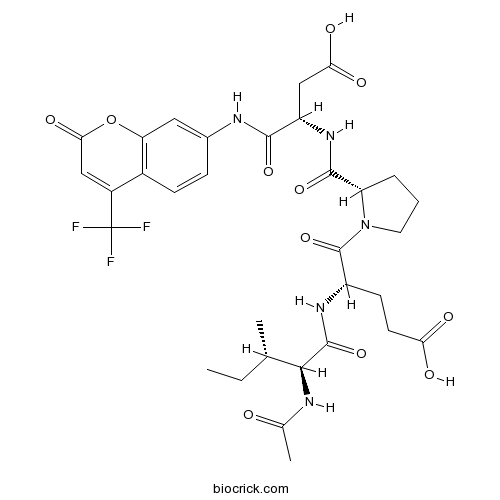Ac-IEPD-AFCRecognition motif for serine protease granzyme B CAS# 1135417-31-0 |

- Amyloid β-Protein (1-15)
Catalog No.:BCC1003
CAS No.:183745-81-5
- Beta-Amyloid (1-11)
Catalog No.:BCC1002
CAS No.:190436-05-6
Quality Control & MSDS
3D structure
Package In Stock
Number of papers citing our products

| Cas No. | 1135417-31-0 | SDF | Download SDF |
| PubChem ID | 25108575 | Appearance | Powder |
| Formula | C32H38F3N5O11 | M.Wt | 725.67 |
| Type of Compound | N/A | Storage | Desiccate at -20°C |
| Solubility | Soluble to 14.51 mg/ml in DMSO | ||
| Sequence | IEPD (Modifications: Ile-1 = N-Ac-Ile, Asp-4 = Asp-(7-amino-4-trifluoromethyl | ||
| Chemical Name | (4S)-4-[[(2S,3S)-2-acetamido-3-methylpentanoyl]amino]-5-[(2S)-2-[[(2S)-3-carboxy-1-oxo-1-[[2-oxo-4-(trifluoromethyl)chromen-7-yl]amino]propan-2-yl]carbamoyl]pyrrolidin-1-yl]-5-oxopentanoic acid | ||
| SMILES | CCC(C)C(C(=O)NC(CCC(=O)O)C(=O)N1CCCC1C(=O)NC(CC(=O)O)C(=O)NC2=CC3=C(C=C2)C(=CC(=O)O3)C(F)(F)F)NC(=O)C | ||
| Standard InChIKey | HWXKKVLJPWMVLL-FGGUPADCSA-N | ||
| Standard InChI | InChI=1S/C32H38F3N5O11/c1-4-15(2)27(36-16(3)41)30(49)38-20(9-10-24(42)43)31(50)40-11-5-6-22(40)29(48)39-21(14-25(44)45)28(47)37-17-7-8-18-19(32(33,34)35)13-26(46)51-23(18)12-17/h7-8,12-13,15,20-22,27H,4-6,9-11,14H2,1-3H3,(H,36,41)(H,37,47)(H,38,49)(H,39,48)(H,42,43)(H,44,45)/t15-,20-,21-,22-,27-/m0/s1 | ||
| General tips | For obtaining a higher solubility , please warm the tube at 37 ℃ and shake it in the ultrasonic bath for a while.Stock solution can be stored below -20℃ for several months. We recommend that you prepare and use the solution on the same day. However, if the test schedule requires, the stock solutions can be prepared in advance, and the stock solution must be sealed and stored below -20℃. In general, the stock solution can be kept for several months. Before use, we recommend that you leave the vial at room temperature for at least an hour before opening it. |
||
| About Packaging | 1. The packaging of the product may be reversed during transportation, cause the high purity compounds to adhere to the neck or cap of the vial.Take the vail out of its packaging and shake gently until the compounds fall to the bottom of the vial. 2. For liquid products, please centrifuge at 500xg to gather the liquid to the bottom of the vial. 3. Try to avoid loss or contamination during the experiment. |
||
| Shipping Condition | Packaging according to customer requirements(5mg, 10mg, 20mg and more). Ship via FedEx, DHL, UPS, EMS or other couriers with RT, or blue ice upon request. | ||
| Description | Peptide sequence shown to be preferred recognition motif for the serine protease granzyme B. Fluorogenic substrate. |

Ac-IEPD-AFC Dilution Calculator

Ac-IEPD-AFC Molarity Calculator

Calcutta University

University of Minnesota

University of Maryland School of Medicine

University of Illinois at Chicago

The Ohio State University

University of Zurich

Harvard University

Colorado State University

Auburn University

Yale University

Worcester Polytechnic Institute

Washington State University

Stanford University

University of Leipzig

Universidade da Beira Interior

The Institute of Cancer Research

Heidelberg University

University of Amsterdam

University of Auckland

TsingHua University

The University of Michigan

Miami University

DRURY University

Jilin University

Fudan University

Wuhan University

Sun Yat-sen University

Universite de Paris

Deemed University

Auckland University

The University of Tokyo

Korea University
Ac-LEHD-AFC is a fluorogenic substrate for caspase-4, caspase-5, and caspase-9.
- 25(S)-Hydroxyprotopanaxatriol
Catalog No.:BCN2495
CAS No.:113539-03-0
- 6-Bnz-cAMP sodium salt
Catalog No.:BCC8043
CAS No.:1135306-29-4
- Altanserin hydrochloride
Catalog No.:BCC7183
CAS No.:1135280-78-2
- KN-92 phosphate
Catalog No.:BCC1682
CAS No.:1135280-28-2
- 3'-Fluorobenzylspiperone maleate
Catalog No.:BCC6752
CAS No.:1135278-61-3
- CGP 78608 hydrochloride
Catalog No.:BCC7087
CAS No.:1135278-54-4
- SR 59230A hydrochloride
Catalog No.:BCC7094
CAS No.:1135278-41-9
- VU 0255035
Catalog No.:BCC7766
CAS No.:1135243-19-4
- VU 0357017 hydrochloride
Catalog No.:BCC7907
CAS No.:1135242-13-5
- Tracazolate hydrochloride
Catalog No.:BCC7115
CAS No.:1135210-68-2
- Moxidectin
Catalog No.:BCC5309
CAS No.:113507-06-5
- Ferulic acid
Catalog No.:BCN5948
CAS No.:1135-24-6
- Magnoloside A
Catalog No.:BCN6013
CAS No.:113557-95-2
- 1,2,3,19-Tetrahydroxy-12-ursen-28-oic acid
Catalog No.:BCN1615
CAS No.:113558-03-5
- Ikarisoside F
Catalog No.:BCN2284
CAS No.:113558-14-8
- Baohuoside I
Catalog No.:BCN5350
CAS No.:113558-15-9
- E-4031 dihydrochloride
Catalog No.:BCC7182
CAS No.:113559-13-0
- Q-VD-OPh hydrate
Catalog No.:BCC1125
CAS No.:1135695-98-5
- Tigecycline mesylate
Catalog No.:BCC4229
CAS No.:1135871-27-0
- Orbifloxacin
Catalog No.:BCC4689
CAS No.:113617-63-3
- 6beta-(Hexa-2,4-dienoyloxy)-9alpha,12-dihydroxydrimenol
Catalog No.:BCN7277
CAS No.:1136245-81-2
- Metasequoic acid A
Catalog No.:BCN6652
CAS No.:113626-22-5
- Stigmast-4-ene-3,6-diol
Catalog No.:BCN6014
CAS No.:113626-76-9
- IDE 2
Catalog No.:BCC6099
CAS No.:1136466-93-7
A combinatorial approach defines specificities of members of the caspase family and granzyme B. Functional relationships established for key mediators of apoptosis.[Pubmed:9218414]
J Biol Chem. 1997 Jul 18;272(29):17907-11.
There is compelling evidence that members of the caspase (interleukin-1beta converting enzyme/CED-3) family of cysteine proteases and the cytotoxic lymphocyte-derived serine protease granzyme B play essential roles in mammalian apoptosis. Here we use a novel method employing a positional scanning substrate combinatorial library to rigorously define their individual specificities. The results divide these proteases into three distinct groups and suggest that several have redundant functions. The specificity of caspases 2, 3, and 7 and Caenorhabditis elegans CED-3 (DEXD) suggests that all of these enzymes function to incapacitate essential homeostatic pathways during the effector phase of apoptosis. In contrast, the optimal sequence for caspases 6, 8, and 9 and granzyme B ((I/L/V)EXD) resembles activation sites in effector caspase proenzymes, consistent with a role for these enzymes as upstream components in a proteolytic cascade that amplifies the death signal.


